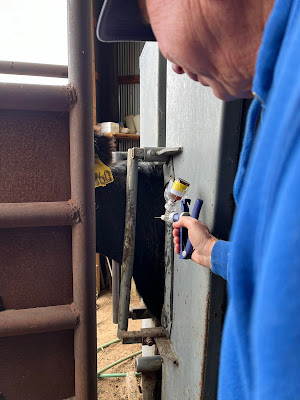Kansas
has nearly 44.8 million acres of agricultural ground. However, not all
this land is suitable for growing crops. Some 22,000 Kansas farmers/ranchers use the 14 million
acres of pasture and rangeland unsuitable for crops for cattle grazing and delivering high-quality protein to consumers through the meat case at grocery stores or sold directly to consumers.
According to the Kansas Department of Agriculture economic model, the beef industry has a direct output of more than $11 billion to the state’s economy, with the ranching and cattle feeding sectors employing nearly 20,000 Kansans and the meatpacking and prepared meat manufacturing industries employing 46,000. Additionally, Kansas ranks third nationally with 6.2 million cattle and calves on ranches and in feedyards. The most recent data shows the state also ranks third in total red meat production, with beef representing more than 6 billion pounds.
Our neighbor, Gary, had plenty of help on horseback as he moved cattle from a circle where they had been grazing on stalks back home to work them. He had told Randy that the "parade" would be passing by our house, so we were watching. Actually, we were listening to begin with. The cattle started their journey about a mile from our house. We could hear them bawling as they ambled closer toward us.
A trailer followed behind to transport any baby calves who couldn't keep up.
That wasn't our only cattle activities this spring. While we retired from active farming in August 2022, we still own our mama cows. We provide the pasture, and Tye and his dad, Todd, do the daily care for the cows and calves for a percentage of the calves born each year.
Randy helped the Millers gather cattle a couple of days and also helped work them. I guess when you're the retired one, you can sit down on the job on occasion.
Randy really did have jobs ...including working the squeeze chute (which was more high-tech than ours was) ...
...and giving shots ... ... and applying the pour-on.
Though I was there mostly to take photos (at Randy's request), I did help write down eartag numbers. Nothing like doing something for old-time's sake, right?
That left Norva Lee free to keep the cows moving down the lane and getting other groups from the adjoining corrals.
And the number list helped Tye know which mama cow was coming up next. The Millers were artifically-inseminating the cows with help from John Fisher, an Artificial Breeding Services (ABI) AI technician.
Todd had gone through the herd and determined which of five bulls they wanted to use for each cow. Tye would get the straw containing the appropriate semen ready for Todd or John to use in the AI process.
The semen straws are stored in these liquid nitrogen canisters until it's time for use. Then, Tye would check ear tag numbers on the list and get the straws lined up accordingly.He put the appropriate straw into a warming unit, so it would be ready for inserting.
John's trailer has stalls for two cows at a time. So both Todd and John could be doing the AI process simultaneously.
Once the process was complete, the cow departed the AI shed and rejoined its corral mates.
***
We didn't have to stick around 'til the cows came home this time - so to
speak. We headed to the Wild West (aka Dodge City) for a dinner theater
at the restored depot.
It didn't include beef on the menu. Instead, it was "airline chicken" to go with the play's military aircraft and pilot theme. That's chicken with a wing sticking up. (I only know that from Food Network.)
The play was pretty heavy, but we had a good time at the Depot Theater.
I told Randy maybe we should go for a comedy or musical the next time.

























Randy must really love keeping his had in without all the stress. LOve the pics of the cattle being moved.
ReplyDeleteIt's always interesting to watch the cattle drive with the horses because we did it differently.
Delete